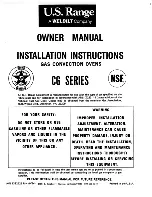
UVP Hybridization Ovens
Page 18
81-0169-01 Rev W
3. Salt Concentration and Temperature
Nucleic acid requires salt (monovalent cations) to reduce the ionic effects of the phosphate backbone,
and heat as a form of non-denaturing kinetic energy. Because the salt concentration and temperature
effect each other, knowing the thermostability of the hybrid probe is helpful. Hybridization rate varies
directly with the sodium ion concentration between 0.03 and 1.2 M. Most protocols run between 0.5
and
1.1 M Sodium.
Situation
Response
G+C = 45-55%
Follow normal protocol
G+C < 45%
Lower salt and temperature
G+C > 55%
Raise salt and temperature
Evidence of probe
Lower salt and temperature
target mismatching
Target and probe is degraded
Hybridize in a formamide-based buffer
on aqueous
solution
Unacceptable high background
Use less probe
Hybridize at lower salt/ higher temperature
Wash with lower salt higher temperature
Incubate with very low salt/change nuclease(solution)
Use a smaller probe or a different probe
Clean probe of contaminants prior to use
4. Aqueous or Denaturing Hybridization Buffer
If hybridization takes place in an aqueous salt environment of 0.8 to 1.2M salt, the T M½ (the
temperature at which the half of the duplex molecules will dissociate under a given set of conditions)
can be 90°C. This is high enough to degrade DNA, RNA and some proteins. It is therefore possible to
add formamide as a denaturing / temperature lowering agent because for every percent of formamide
in the reaction the TM½ is reduced by 0.65°C. Therefore, at 80% formamide, reactions can be
performed in the 40 – 55°C range. However the rate of formamide-based hybridization is at least three-
fold lower than that of aqueous hybridization requiring longer incubations.





































